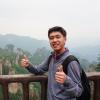As part of the IES Abroad program, housing is provided to students through Costarricense host families. As I mentioned in my 1st blog, all of our host homes are located in Santo Domingo de Heredia and are within distance to one another. My Costarricense family consist of my host mother, her son, and her two grandchildren. Being a native Spanish speaker has allowed me to communicate with my family easily and has allowed me to help out my compañeras (female classmates). It has also given me the opportunity to practice the Spanish language and in the process gain a deeper understanding of its regional differences.
The first module course students are required to take is Spanish. This course is offered at three levels (beginner, intermediate, and advanced) and students are only required to take one level. For another compañera and me, the choice was different because we are both native Spanish speakers. The course we took was Contemporary Issues in Costa Rican Culture 312 and it was taught by Professor Karina Soto. The location of the course was at Inbio Parque which is the current student center for IES Abroad in Costa Rica. As mentioned in the syllabus the course gave an overview of Costarricense culture from a historic perspective, highlighting different cultural and social results explaining the modern Costa Rica.
One of the first activities we did for class was attend a conference of four Costarricense indigenous women. The conference took place at the National University of Costa Rica in the city of Heredia. These women spoke about their experiences as women which intersected with their indigenous identities and their age. One of the issues that was highlighted was the limited access to education among indigenous populations in Costa Rica. This is a social issues that can be seen in other Latin American countries as well.
During our first field trip, we visited Sabana cemetery in San José and examined the different social classes noted among tombstones. That same day we visited the Museo de Arte Costarricense (Museum of Costarricense Art) which is also located in San José. This museum has a variation of Costarricense art and is highly recommended for anyone visiting Costa Rica. My favorite art piece was El mural del Salón Dorado (The Golden Room Mural). As the name implies this mural takes up the wall of a whole room and is made of stucco carved in bas relief. The mural depicts significant Costarricense historical events that lead to the year 1940. I also enjoyed the beautiful prints of Pre-Columbian art by artist Francisco Zúñiga. Our final field trip was visiting the small town of Orosi where we saw one of the oldest churches of Costa Rica. In comparison to San José, Orosi is very calm, quite, and peaceful. I absolutely love the scenery of green mountains surrounding the town.




















Sergio Cueto
<div> </div>
<div><span style="color: rgb(29, 29, 29); font-family: Arial, Verdana, sans-serif; font-size: 12px; line-height: normal; background-color: rgb(237, 237, 237);">Hello! My name is Sergio Cueto and I was born in the city of Juarez, Chihuahua located in Mexico. I came to Chicago when I was two years old and currently reside in the Logan Square neighborhood of the city. I am an undergraduate student at the University of Illinois at Chicago, majoring in Latin American and Latino Studies with a minor in Sociology. I am also a volunteer for the Chicago Latino Film Festival. I love photography, films, reading, writing, video games, and spending time with friends and family.</span></div>





